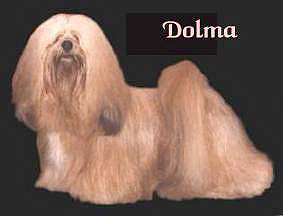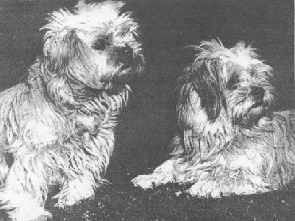 My
name is Catherine
Marley. I have
been breeding and exhibiting Lhasas for 37 years. I work closely, and
visit
frequently, with breeders in France, Germany, Austria, Switzerland, and
Denmark, so I have some European perspective as well as the local (USA)
one. I am a Physician, and have published many articles on Lhasas over
the past 35 years. I am a member of the Danish Lhasa Apso
Club, and the American Lhasa Apso Club.
My
name is Catherine
Marley. I have
been breeding and exhibiting Lhasas for 37 years. I work closely, and
visit
frequently, with breeders in France, Germany, Austria, Switzerland, and
Denmark, so I have some European perspective as well as the local (USA)
one. I am a Physician, and have published many articles on Lhasas over
the past 35 years. I am a member of the Danish Lhasa Apso
Club, and the American Lhasa Apso Club.
I acquired my first Lhasa, Tsu-Tsu, in November, 1972. The breeder suggested I take her to some matches. From there we graduated to dog shows. At the shows I saw a few dogs of a different, and most beautiful type. These were dogs from the West Coast, from Mrs. Grace Licos. As I began to study the breed, I realized that Tsu-Tsu was not the authentic type of Lhasa with which I wanted to continue. In the Spring of 1973, I met Mrs. Licos and asked her for a bitch puppy when she had one. Later that year, Licos Pechen-La arrived. Tsu- Tsu was spayed and given to a family who loved her dearly until she died at age 18.
 Pechen
-La was
bred to a beautiful Hamilton dog from California, Ch. On-Ba Jo-Bo. In
December,
1974, this breeding produced my first home-bred Champion,
Ch. Kai-La-Sha ROM. Dolma was the most beautiful animal I
have
ever owned,and
the most intelligent. She had only 3 litters, and produced 4 Champions.
After knowing Dolma, there was no thought of breeding anything but a
line
derived from Hamilton and pure Tibetan sources.
Pechen
-La was
bred to a beautiful Hamilton dog from California, Ch. On-Ba Jo-Bo. In
December,
1974, this breeding produced my first home-bred Champion,
Ch. Kai-La-Sha ROM. Dolma was the most beautiful animal I
have
ever owned,and
the most intelligent. She had only 3 litters, and produced 4 Champions.
After knowing Dolma, there was no thought of breeding anything but a
line
derived from Hamilton and pure Tibetan sources.
At this point, I began corresponding with Gloria Fowler (Everglo). I had been impressed by several dogs of her breeding. They had the type plus the soundness and movement I was looking for. Gloria sent me a little red bitch of superb type, Everglo Autumn Amber. I later acquired a succession of dogs from her, most of them loaned to me for breeding, and I sent dogs to her. When I visited Gloria, I was not disappointed. Old Everglo Rempa, at 16 years, moved like the wind around her small garden, as did many others. The temperaments of these dogs impressed me as well. All her males ran together peacefully, as did her females.
For a number of years, I continued, through my relationship with Gloria, to breed based on the Licos and Everglo lines. Later, I incorporated Tabu lines which were also based on many of the same original Tibetan imports. Since then I have continued breeding within Hamilton and other Tibetan lines, as these dogs provided that ideal combination of authentic type, soundness and longevity.
Lhasa Apsos are companions first and foremost, and I feel that a good Lhasa must have the characteristics that make it a good companion. The Lhasa Apso is also an animal which developed in the harsh conditions of the Himalayan mountains. A good Lhasa, therefore, should be an animal equipped for survival at high altitude and extremes of climate and terrain, requiring a minimum of care. This philosophy has guided my breeding for over 35 years.
 Le and Phema - 1950 Imports from Tibet |
Correctly
researched and
worded
standards, and an accurate understanding
of the breed's history, are fundamentally important to the
breeding
of purebred dogs. How can people expect to successfully breed without
an
educated understanding of these two fundamentals?
I
think a significant number of breeders
today are actually trying to
produce dogs that fit the standard but this is a multi-generational
plan
down a road strewn with pitfalls. Once begun, a breed's
distortion (as a
breed)
is difficult to remedy.
Unfortunately for the breed, the control of type by means of a standard works only so long as the vision of the people in charge is on course. Things go wrong when breeders and judges begin to believe that if a slightly compact dog is good, a very short back is even more so, and if very narrow rears are unattractive, then very wide rears are desirable. If a particular type of construction has achieved a flashy look in the ring, then that is seen a correct construction for the breed. As a result, many Apsos now have concave backs, short upper arms, upright shoulders and tipped up pelves: the result is an unnatural, man-made gait which is extremely hard on the entire front assembly. It looked right but for the wrong reasons. It definitely didn't produce a dog that could hold together over time or even do all the things Lhasa Apsos should be able to do. Among these jobs is jumping and scaling obstacles.
The original function of the breed is that of an hardy mountain companion and watchdog. Its mountain heritage requires a dog that has great economy of motion and minimal wear on his body. He is athletic and well-muscled with great agility and elasticity. "Great economy of motion and minimal wear on his body" is not possible with an exaggerated, man-made gait. The show dog subculture becomes absurd when show ring awards are seen as validation of a breeding program even when the show dogs have become unnatural exaggerations of their original ancestors. I know of no breed whose original work or reason for being was to trot in a small circle inside a square bordered by baby gates. Certainly the Apso was never bred for this!
My orientation toward the breed is more that of a naturalist and conservitor than a show breeder. Central to my mission is the idea of preservation of the original and authentic type of Lhasa Apso. Not only is this breed nearly extinct in its native land, but the people and the culture that created it as well. Mass killing and deportation of the Tibetan people, and resettlement by Chinese is going on as I write this. This genocide and culturecide is largely ignored by the western governments and press. We who have Lhasa Apsos own a little part of the Tibetan culture. It is up to us to preserve it, unchanged. Changing the survival oriented type of the true Tibetan Lhasa in response to fad and fashion, is a betrayal of our responsibility to care for these little pieces of Tibet entrusted to us.